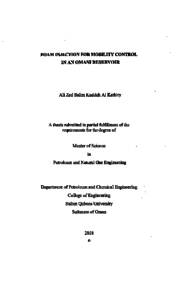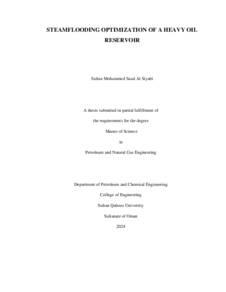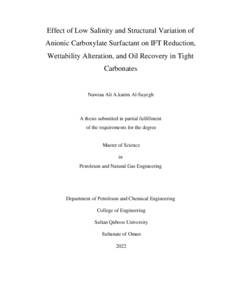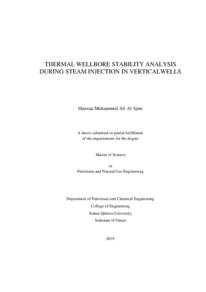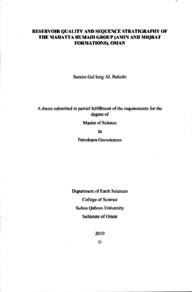Document
Foam injection for mobility control in an Omani reservoir
Publisher
Sultan Qaboos University
Gregorian
2018
Language
English
English abstract
In gas flooding processes, poor sweep efficiency is seen due to low viscosity and OT SI density of gas characteristics. Whereas foam injection is a promising method to control the mobility and reduce the gas bypass due to gravity override and heterogeneity of layers in the formation. The existence of a foaming fluid in porous rocks can decrease the mobility of gas and water, allowing to stabilize gas injection front and prevent an early production of water or gas. The unique properties of foam can help the reservoir engineer in several ways to enhance oil recovery (EOR) and recover the economics of mature oil fields. There are a number of factors which influence the properties of the foam, such as temperature and pressure conditions, the property of the rock, salinity of the water, surfactant foaming capability, type of gas and oil, and injection strategies. Performance of foam is affected by any changes in these parameters, consequently, the end result of the foam application. Therefore, it is imperative to recognize foam on a broad experimental scale. Nevertheless, foam flow interactions between oil and gas under immiscible conditions are still not fully understood. In this study, different surfactants were collected and analyzed for surface active properties by measuring the surface tension at ambient temperature and pressure. It has been found that locally produced Linear Alkyl Benzene Sulfonates (LABSA) yielded surface tension of 32 mN/m at CMC of 1.5 wt%. Simulation using STARS CMG was done for the Omani carbonate reservoir for permeability ratios of 21:1, investigating several injection strategies consisting of 2 models and 6 scenarios each, and several foam scan experiments were conducted using several surfactants, and Nitrogen (N2) as a model gas, under high temperature of 60 °C and pressures of 300 psi, and 400 psi. It has been found that Internal Olefin Sulfonates based foam (IOS 0.5 wt%) can generate apparent viscosities of 270 cp at foam quality 0.7, resulting in high-pressure drops (17 bar) inside the 10-inch core. Under higher salinities (4 wt% NaCl), IOS can generate apparent viscosities of 220 cp at foam quality 0.7, in essence, salinity is
inversely proportional to apparent viscosity. Studies have shown that foam has higher apparent viscosity in high than in low permeability region. Thus, the use of foam in heterogeneous system is attractive to get better sweep efficiency (Yan, 2005). Simulations done found that foam can generally improve sweep efficiency by 1% to 10% and reduce the gas-oil ratio by 60% under various foam injection strategies. The volume of the surfactant solution is shown to have a slight proportionality to sweep efficiency. The simulation results for a highly heterogeneous low permeable reservoir (1-21 mD), showed that multiple slugs over a period of 3 years would yield higher recovery (43%), and significantly reduce gas-oil ratio (5000 m2/m"), over all. Under
similar conditions in an anticline model, it has also been shown in the simulations that closer the injectors are to the producers, the better the performance of the foam flooding process. In permeability ratio of 10:1, the single slug of foam injection scenario of 12 months slug size yielded comparable results to the multi-slug 12 months - 3 years interval scenario. Revealing that a large single slug is sufficient for lower permeability ratio reservoirs.
Description
Thesis
Member of
Resource URL
Arabic abstract
في عمليات تعزيز الإنتاج النفط بالحقن الغاز، غالبا ما تعاني من ضعف كفاءة التدفق الحجمي للنفط بسبب اللزوجة المنخفضة للغاز، فالحق بالرغوة هي طريقة واعدة للتحكم في الحركة والحد من تجاوز الغاز بسبب تجاوز الجانبية وعدم التجانس للطبقات في المكمن النفطي. بإمكان وجود سائل رغوي في الصخور المسامية إلى تقليل حركة الغاز والماء، مما يسمح بتثبيت جبهة حقن الغاز ومن إنتاج الماء أو الغاز مبكرة. وبامكانها أيضا أن تساعد مهندس المكامن بسبب خصائص الفريدة للرغوة في عدة طرق لتحسين استخلاص النفط (EOR) واستعادة اقتصاديات حقول النفط الناضجة هناك عدد من العوامل التي تؤثر على خصائص الرغوة, مثل درجة الحرارة وظروف الضغط وخصائص الصخور, وملوحة الماء, وقدرة الصابون لأنتاج الرغوة ونوع الغاز والنفط واستراتيجيات الحقن. يتأثر أداء الرغوة بأي تغيير في هذه المعلمات, وبالتالي النتيجة النهائية في عملية حقن الرغوة. لذلك من الضروري التعرف على الرغوة على نطاق تجريبي واسع. ومع ذلك فإن تفاعلات تنفق الرغوة بين النفط والغاز في ظروف غير قابلة للامتزاج ليست مفهومة بالكامل. في هذه الدراسة، تم جمع مواد الصابون التحليل، وتم دراسة التوتر السطحي للصابون، عند درجة الحرارة المحيطة والضغط الجوي. وقد وجد أن المنتج المحلي الكيل البنزين سلفونات الخطي (LABSA) بلغ تفاعل السطحي لها 32 ميللي نيوتنام في مركز ال CMC بنسبة 1 . 5% بالوزن. أجريت المحاكاة باستخدام (STARS CMG) المكمن كربوني عماني لنسب النفانية بنسبة 211: ، حيث قد تم البحث في العددي من استراتيجيات الحقن المكونة من نموذجين و 6 سيناريوهات لكل منهما, وأجريت العديد من تجارب حقن الرغوة (coreflooding) باستخدام عدة صابون، والنيتروجين (N2) باعتباره نموذج الغاز، تحت درجة حرارة عالية من 60 درجة مئوية والضغط من 300 ، و 400 رطل على البوصة المربعة لقد وجد أن الرغوة المحتوية على سلفونات اولقين الداخلية (IOS %0
Category
Theses and Dissertations

